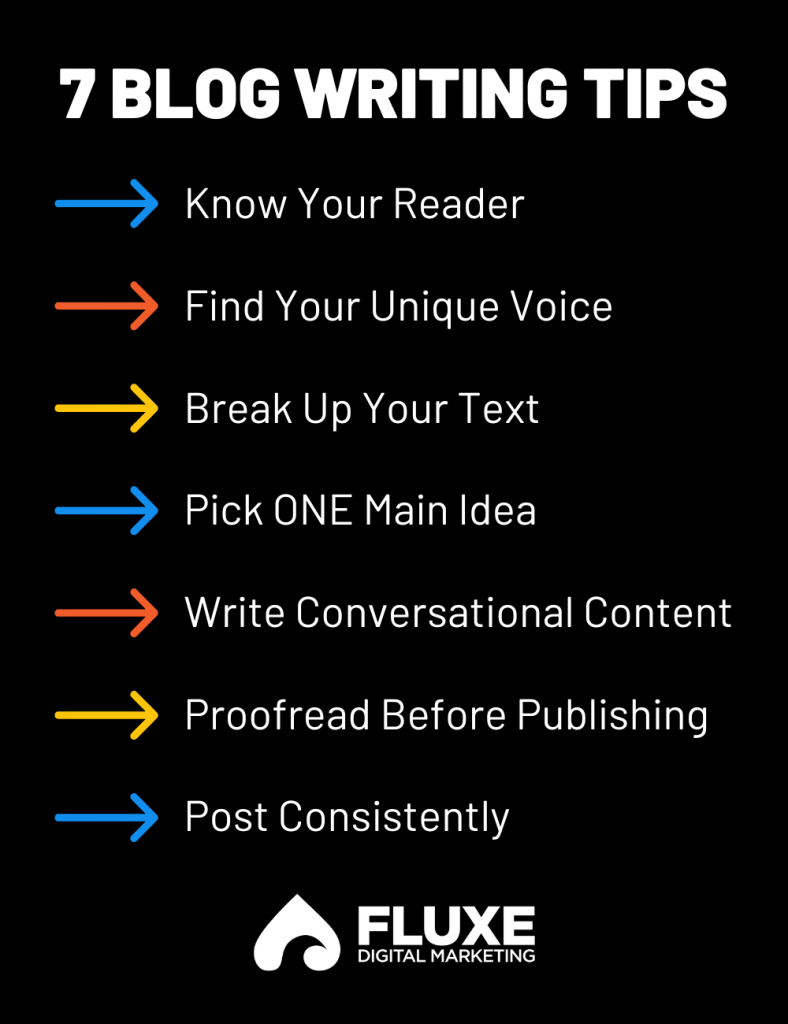You’re a business owner with unique expertise to share. You recognize blogging can land your website on the first page of Google and attract perfect-fit customers. But you’re not ready to hire a professional ghostwriter or content marketing agency, at least not right now.
Writing blog posts that connect with your audience takes skill and time. It’s a craft we’ve honed here at Fluxe through years of experience writing, editing, and proofreading for CEOs and other industry leaders.
And I’m here to share our secrets.
If you want to write great content that keeps ideal prospects coming back again and again, follow the seven foundational tips below.

7 Blog Writing Tips for CEOs
1. Know Your Reader
Before you put pen to paper (well, fingers to keys), you must identify your ideal reader.
Don’t envision your audience as a nameless, faceless mass. Imagine you’re writing for one person in your target demographic.If you can think of someone you know personally, even better.
What language resonates with that person? What are their pain points? What background knowledge do they have? Why should they care what you have to say? The more specifically you can answer these questions, the better positioned you’ll be to create relevant content.
As you write each post, approach it as a conversation with your ideal reader rather than as a speech directed into the ether. Share insights that address their needs and engage their interests. Sympathize with them and show you understand their situation.
Writing this way provides genuine value rather than promotional hype.
2. Find Your Unique Voice
As of this writing, there are about 1.09 billion websites on the internet, some boasting thousands of pages, articles, and blog posts. So, whatever you choose to write about, I guarantee you’re not the first person on the internet to write about it.
Does that mean you shouldn’t write or you have nothing unique to say? Absolutely not.
The difference between you and all the other subject matter experts who’ve written about a topic is your singular perspective, experience, and personality.But it can take effort to translate that differentiation into an engaging written tone.
Think about how you might explain concepts to a customer over lunch or to friends around a campfire. Let your humanity shine through. Don’t be afraid to write informally (more on this in tip #5), even while retaining professionalism.
Use the same voice consistently across all your posts to build connection and trust with your readers over time. Just be sure it aligns with you and your brand’s existing tone of voice. For example, forced humor or cleverness comes across as inauthentic and damages credibility.
3. Break Up Your Text
Research consistently demonstrates that we humans read text on screens differently than we read physical books and newspapers.
When we read on our phones, laptops, and tablets, we don’t read as deeply. We tend to skim, our eyes jump around, and our reading comprehension skills take a hit.
That doesn’t mean you should abandon the blog medium. Regardless of reading comprehension stats, people these days get most of their information online. It simply means you need to make your blog content easy on the eyes. Here’s how:
Keep It Short and Sweet
Blog posts are meant for quick, convenient consumption. Assume you don’t have your reader’s full attention and that work, lunch, or travel is happening around them.
Long sentences lose readers fast, especially on a screen. Lots of commas and conjunctions create hurdles to understanding. Even if you’ve written the world’s most beautiful complex sentence, your reader will likely lose focus by the end.
Keep your sentences brief.
Limit Paragraphs to 1–3 Sentences
In school, many of us learned to write the five-sentence paragraph, moving on only when we had a new idea to explore. This is a principle of academic writing, NOT blog writing.
On screen, walls of text overwhelm even the most seasoned readers. There’s just something our brains don’t like about them. Our eyes are much happier when they can jump from one distinct bit of isolated text to another.
The white space between paragraphs reduces eye strain and gives readers much-needed micro-breaks throughout a piece. Plus, short paragraphs help you sound more conversational.
Use Subheadings as Signposts (Like This!)
Subheadings give readers something to hold on to as they move through your post, and they provide another type of break for the eye.
Subheadings also help readers track a blog post’s development. Then, when they glance up from their phone to confirm a subway stop, deli order, or Uber Eats delivery, they can find their place again quickly.
4. Pick ONE Main Idea
How many times have you walked away from reading something online and immediately forgotten the point of what you read? If you’re like most people, it’s probably happened more than once.
Because the typical blog reader’s attention is split, keeping blog posts focused on one main idea ensures you leave your reader with a strong takeaway. In other words, they’ll remember your point — and your brand.
This doesn’t mean you can’t have multiple supporting points, but they all need to be in service of the single main point.
Make sure the flow of your post builds to a logical conclusion (your main point):
- Does the introduction set up the blog by connecting with the reader’s pain point?
- Does the first main section flow logically from the intro, and does the next section build logically upon that?
- Does it all flow into a final section or conclusion that leaves the reader with a solid takeaway (a change in perspective, a useful approach, an action to take, etc.)?
This structure will keep your post focused on your point and make sure your reader walks away with the value you’re trying to provide.
The exception, of course, is list posts. But even a list post maintains a focus and keeps the descriptions of each list item streamlined.
5. Write Conversational Content
The standard rules of academic writing you learned in school don’t necessarily apply to blogs. Modern digital readers appreciate informality and brevity.
Here are some legitimate style choices you can make that would break your seventh-grade English teacher’s heart:
- Use contractions. “You’re” instead of “you are,” for example.
- Embrace “I/we” and “you.” It’s okay!
- Split your infinitives. Remember Star Trek’s intro? Turns out, “to boldly go” is the best phrasing.
- When necessary, end a sentence with a preposition. Gasp! Don’t worry; Merriam-Webster and the New York Times agree.
However, these choices depend on your audience. Does your ideal reader want you to sound like an academic? If so, reconsider our tips, but most digital readers want you to sound conversational.
You can sound conversational AND highly professional if that’s best for your audience. Or, maybe you’d like to sound warm and friendly or sharp and witty. Whatever you choose, be consistent, don’t depart too much from how you sound as a person or brand, and remember — writing is a conversation.
6. Proofread Before Publishing
Even the most talented writers leave typos, unclear phrases, and disjointed paragraphs all over initial drafts. And that’s okay. You’ll get more written if you don’t try to self-edit along the way.
So, write first; revise later. The essence of good writing is rewriting. (Thanks, William Zinsser!)
When you’re happy (enough) with your polished draft, step away from it for a day or two before you proofread. After getting some distance, you’ll be better able to catch those little mistakes we all make when we get in the zone. If you make any substantial changes, be sure to proofread again afterward.
A second set of eyes may catch minor mistakes you miss, so consider enlisting a trusted colleague, friend, or freelancer to proofread as an additional quality check.
Remember, each post represents your brand. Publish only finished content, not rough drafts. A few sloppy errors can undermine your credibility.
7. Post Consistently
The first six tips will help you create stellar individual posts. But to earn attention from both Google and five-star-fit prospects, you need to publish on a consistent schedule, whether it’s weekly, biweekly, or monthly. Both algorithms and humans want to know when to expect your next piece.
Making time to write while simultaneously running a business isn’t always feasible long-term. When the pressures of business as usual collide with editorial calendars, creating original content tends to slide down the priority list.
If this happens to you, don’t beat yourself up. It’s not a failure or a sign of weakness. Blogging one time, let alone on a regular schedule, isn’t easy. That’s why we have a whole team of seasoned content marketing specialists here at Fluxe.
If you want the benefits regular content production can bring but don’t have the time or bandwidth to DIY it, get in touch. Our experienced team knows how to manage the behind-the-scenes nitty-gritty, leaving you free to run your business and share your unique expertise with the world.




